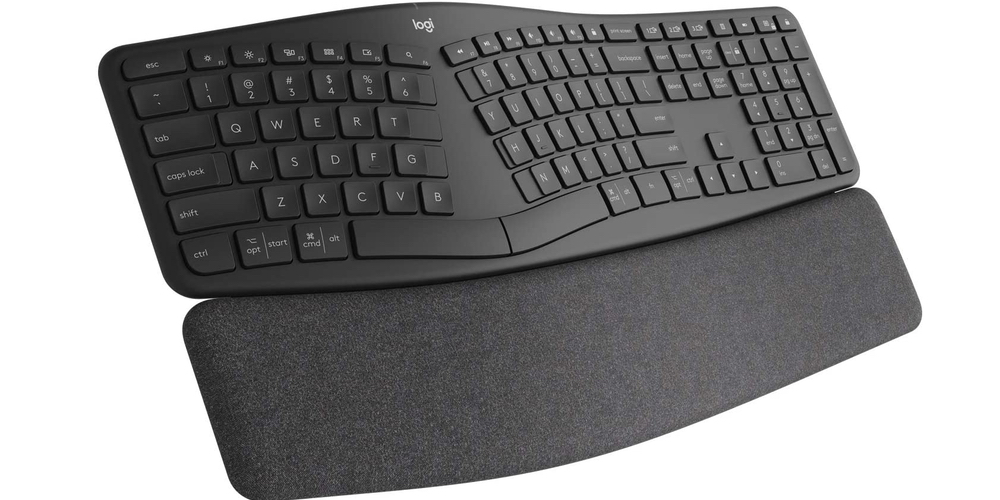Do Ergonomic keyboards work? This thoughts must have crossed your mind when planning a shift to an ergonomic keyboard to reduce side-effects of work stress on your wrists and hands. The shift to an ergonomic keyboard is a must when you’re typing more than regular (emails, group chats, preparing presentations, etc.); your wrists and hands hurt more than usual.
However, you might still be in two minds about the functionality and value you expect from this. There is still a debate on ergonomic keyboards and if they are worth the shift. This article will get down to the business and enlighten you about the pros and cons of ergonomic keyboards along with other essential information such as – what are ergonomic keyboards? types of ergonomic keyboards? and more!
What is an Ergonomic Keyboard?
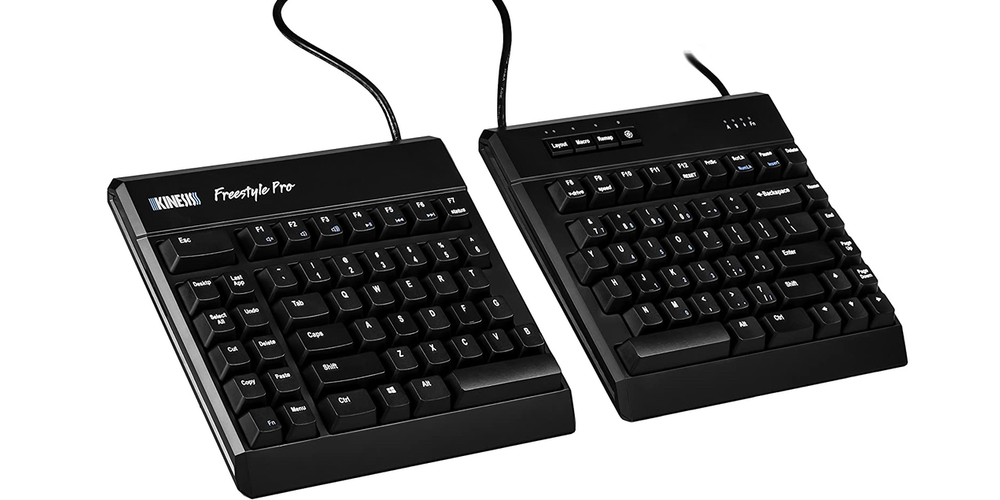
A standard keyboard was thought up by someone looking for the computer’s physical form, not our body parts. Conventional keyboards are flat, which means you have to stretch out your fingers and make unnatural movements.
In contrast to standard keyboards, ergonomic keyboards are designed to fit user requirements and health needs—a keyboard designed with ergonomic considerations to reduce muscle strain on wrists.
An Ergonomic keyboard is a specially designed computer keyboard to reduce stress on your wrists and forearms while typing. These keyboards’ unique contour designs are split in half, wherein each half is positioned at an angle to match your wrists’ shape while typing.
Ergonomic keyboards center on natural hand and wrist positions to accommodate long typing sessions.
The standard keyboards that most users get with their PCs are just elongated rectangles with 108 keys, which are suited for short durations but negatively impact body posture in the long run as users have to squeeze their elbows and wrists to type on them.
Studies on human factors and ergonomics (HF&E) show how human bodies interact with the hardware to optimize. An ideal keyboard should fit naturally with human needs and not cause excessive fatigue. And that’s what ergonomic keyboards aim to be.
An ergonomic keyboard has keys split down to the middle between TGB and YHN and the space bar. Both sides are angled upwards or domed to elevate the center.
Types of Ergonomic Keyboards
As the name implies, these keyboards are designed to improve productivity and reduce fatigue while working. They may resemble standard flat keyboards for a quick look, but they are different in terms of layout and shape.
Speaking of which, there are three types of ergonomic keyboards that you will find on the market.
Contoured Keyboard
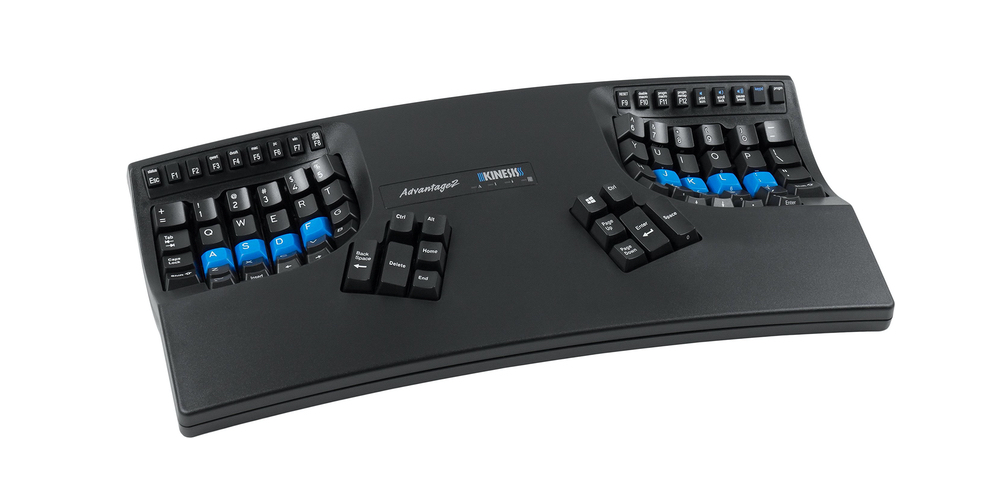
A keyboard (shaped like domes or waves) helps in naturally positioning your arms and wrists when typing. You can check out the 1977 Maltron or the newer Kinesis Advantage to see how contoured keyboards have evolved.
The keys are placed into two depressions in such keyboards, adjusted at shoulder width, and function keys positioned for thumbs access. Contoured keyboards require less arm and wrist movement.
Split Keyboard
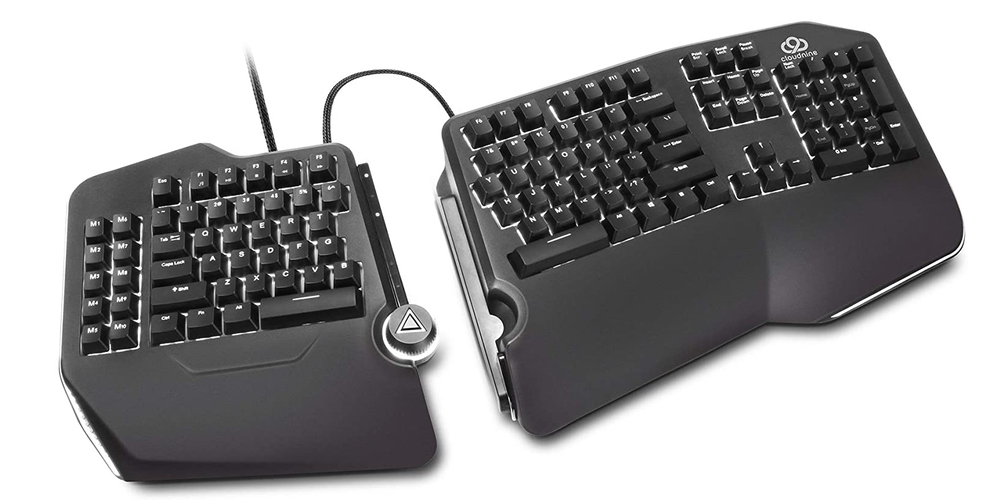
This type of ergonomic keyboard is split in the middle. Even the number pad could be placed separately for such keyboards to benefit comfort, flow, and hand spacing while typing.
A split keyboard with the keys separated into two or three groups that allow users to type at different angles than a traditional flat keyboard is called a fixed-split keyboard.
On the other hand, the keyboard that comes split into several independent pieces for custom angling to be done by the user is called an adjustable split keyboard.
Handheld Keyboard
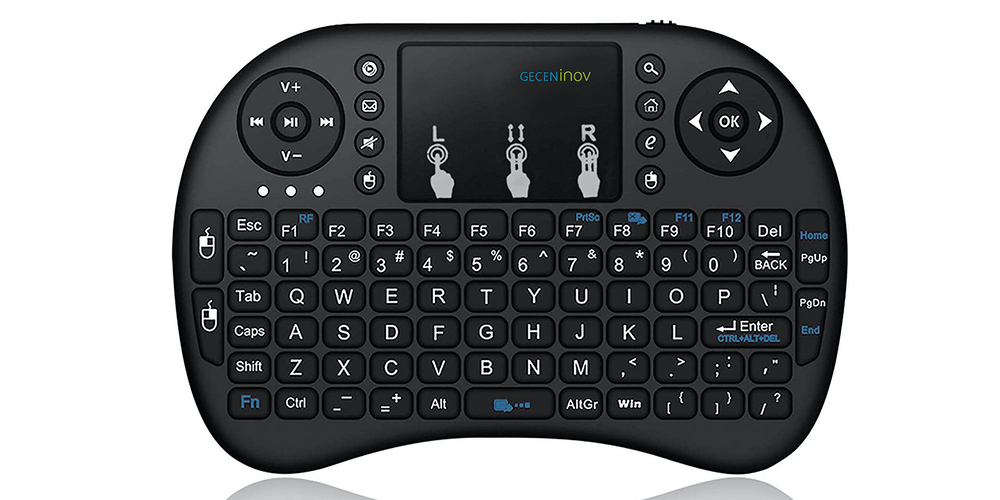
Handheld keyboards are based on the design language closer to a game controller and with the advantage of portability. They offer a form factor that can mingle with any surroundings; a user can use such keyboards even when sitting on a chair or a bean bag.
These keyboards can be used in front of the screen or away from it too. Some of the variations of a handheld keyboard also come upgraded with a trackball mouse functionality.
Angle Split Keyboard
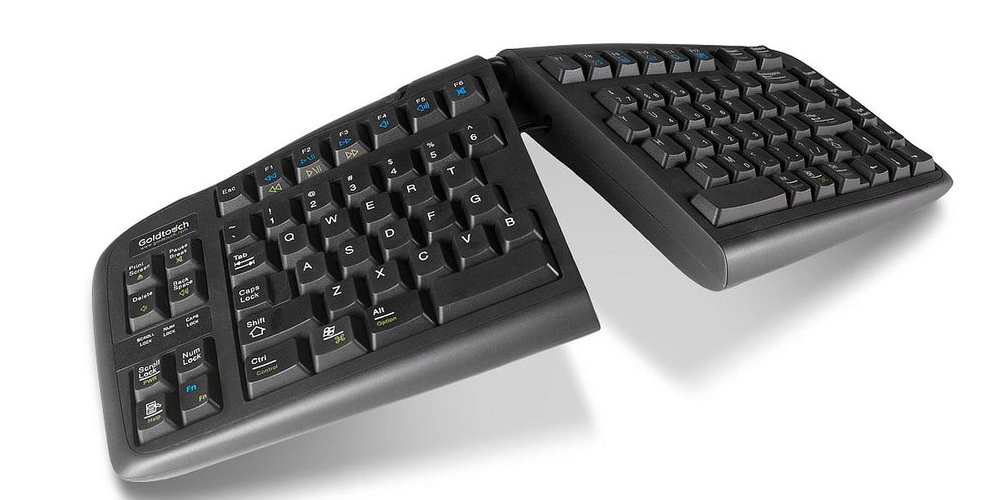
Also known as the Klockenberg keyboard, Angle Split keyboards are similar to a split keyboard but with the middle spread elevated like a dome to keep index fingers on a higher surface than little fingers.
Except for this special design change, Angle Split keyboard functions the same as a splitkeyboard.
Recommended Read: Top 10 Best Ergonomic Keyboards
Pros of Ergonomic Keyboards
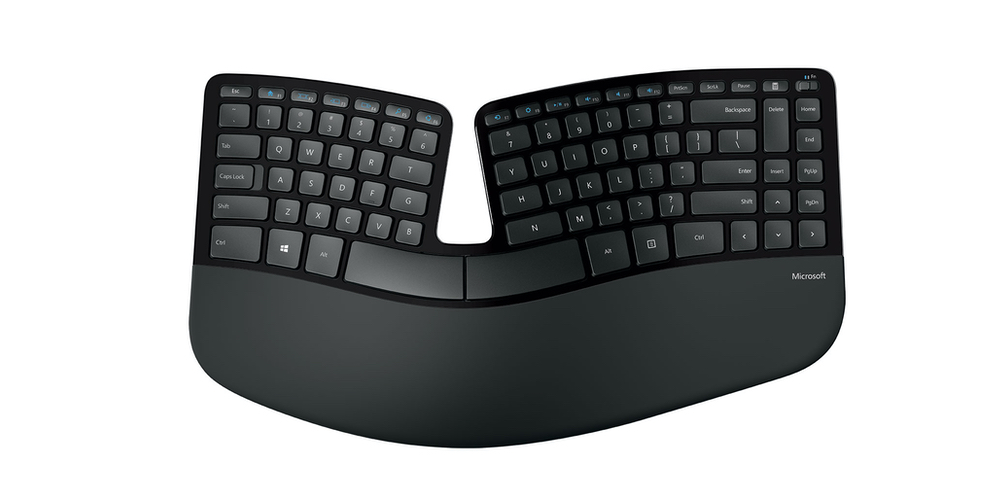
The USP of a keyboard lies in its comfort and health benefits. Such keyboards are also vouched for reducing the risk of injury, boosting productivity, and preventing fatigue.
Let’s look at some pros of using an ergonomic keyboard.
Comfort & Support
The design of an ergonomic keyboard offers more resting space for the wrist and forearm as you type. The design naturally places your arms to avoid strain and add to overall comfort. Such keyboards ensure that your fingers are closer to the keys while typing, which reduces movement and effort.
Reduce Risk of Carpal Tunnel Syndrome
An ergonomic keyboard promotes the natural positioning of wrists and forearms when typing. These keyboards have a narrower design that minimizes the strains when reaching for the mouse.
The design reduces the risk of catching carpal tunnel syndrome that usually occurs when using traditional keyboards for a long time due to pinching of a nerve in your wrist by hand movements like reaching for the mouse.
Ease of Use
Suchkeyboards primarily help users who are sensitive to wrist and forearm pain due to prolonged typing, like writers, coders, and other professionals.
The keyboard contours offer comfort while typing and are easy to use after the initial phase when a user gets accustomed to the new design.
Once a user gets around the design and key placements of an ergonomic keyboard, everything runs smoothly and without any posture pains.
Increase Typing Speed
There is likely a significant increase in the typing speed as a user types in a more natural setting for their wrist and arms. Also, if you don’t have a good numeric keyboard laptop and your word processing job pinging for an upgrade, an ergonomic keyboard saves you financially in those circumstances.
The more time users spend on getting used to an ergonomic keyboard, the more they get accustomed to the key placements that eventually lead to better and faster typing.
Additionally, users can work for more extended periods as they have a relaxed wrist and comfortable finger positioning.
Combinations Come Easy
Using an ergonomic keyboard like a split keyboard, it becomes easier to get used to two-and-three keys combinations. It is more comfortable to use complex combinations involving Alt, Shift, Delete, and Ctrl keys.
Enhanced Productivity
Ergonomic keyboards promote typing in a relaxed position that reduces fatigue and helps in improving productivity.
Compared to a regular keyboard, that causes fatigue, which hampers task completion speed and overall work performance. An ergonomic keyboard improves the capability to work and increase productivity by conserving both time and money.
Hotkeys To The Rescue
Many of the top ergonomic keyboards come geared with some variation of hotkeys. These pre-programmed hotkeys help in saving precious time as users end up saving extra effort while working.
Hotkeys boost overall work efficiency. They are like pre-programmed shortcuts on your keyboard. Many ergonomic keyboards also allow customizing these hotkeys to suit your working style.
Designed for Heavy Work
Ergonomic keyboards are designed to take a heavy load of work. For example, programmers or developers who spend long hours coding do not get worked up using an ergonomic keyboard as their wrists and hand position does not cause any pain.
The increased productivity means a higher amount of time spent typing on the keyboard, but ergonomic keyboards are meant to handle the considerable workload.
Cons of Ergonomic Keyboard
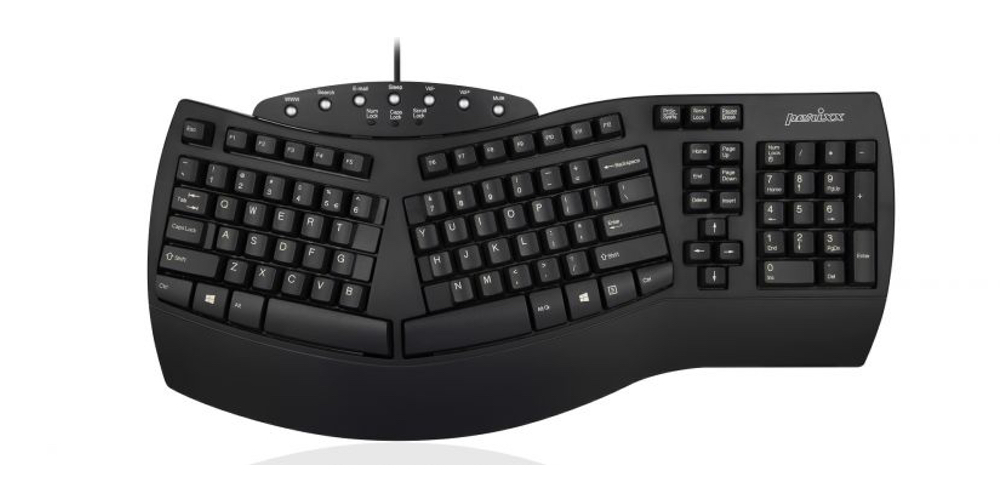
While there are many benefits that we can list for an ergonomic keyboard, there are also some disadvantages. Check out some of the major cons of an ergonomic keyboard.
Preventive Not Cure
Ergonomic keyboards are strictly preventive, which means that they minimize risks such as a carpal tunnel. They are not a cure for treating wrist and arm related injuries caused by prolonged typing hours.
So, they will prevent such health issues, but if you already have one, then you must consult a doctor to treat them and then maybe shift to an ergonomic keyboard for better posture.
Not Affordable
Ergonomic keyboards do not come cheap. In fact, a decent one could set you back by $100.
The cost of Ergonomic keyboards is one of the major reasons why some users stick to their regular keyboards.
The cost difference is quite significant compared to a traditional keyboard that could be purchased at a much lower price.
Takes Time To Get Accustomed
The design of such keyboard is different from a conventional one, which means that when users make a shift, they have to spend hours getting used to the new design and typing space.
While this may not be a big con for people who do not spend much time typing, it could pose a big issue for working professionals who type a lot.
The ‘getting accustomed’ phase could bring down their productivity for some time.
Requires Extra Space
Thanks to their different design (usually split or tent) than a regular keyboard, ergonomic keyboards end up taking extra space on your work desk.
If you are someone who likes working from home but does not have a big desk to accommodate any peripheral that demands the ace of space to fit in, you may need to rethink your buying decision for an ergonomic keyboard.
Or you could also think about bidding farewell to your existing desk for a bigger one to house such keyboard. It all boils down to the need and choice.
Compatibility Issues With Non-Windows Setup
Many of the ergonomic keyboard lineups are not fully compatible with the non-windows environment like macOS.
A fair chunk of such keyboards come equipped with extra functionality keys, which are not compatible with macOS.
Some even face problems after installing the driver. If you are looking for a keyboard to work with macOS, you better test it out and learn about compatibility with the operating system.
Conclusion
In the end, to answer the burning question – Do Ergonomic Keyboards Work? We would say that choosing or shifting to an ergonomic keyboard could be disconcerting initially, but it will feel a lot less stressful for your wrists and elbows.
The peripherals industry highly caters to regular keyboards and not ergonomic ones. This leaves shoppers with fewer opportunities to test ergonomic keyboards in person.
Still, for working professionals who type a lot, an ergonomic keyboard can bring a slew of improvements to your workspace and health.
Such keyboards center on natural hand and wrist positions to accommodate long typing sessions.
There are some fascinating keyboard variations out there, and you will find the one that suits you the best.
Are you an ergonomic keyboard user? Let us know in the comments about your favorite thing about them. Plus, also see a good list of best word processing laptops for authors and writers.
